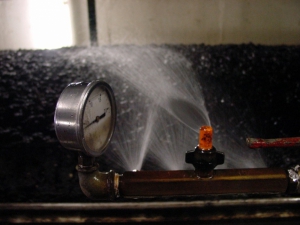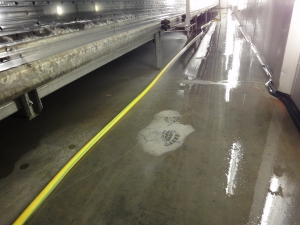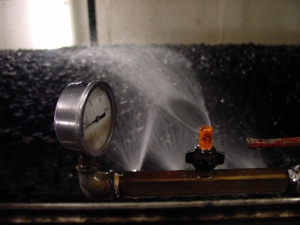Water, the ongoing discussion
If one wants to start a discussion with a grower (or with a consultant), start talking about watering.
How much, when and what watering method.
To make any sense though, you first have to define the period. There is watering on casing soil and watering over mushrooms and between flushes.
This blog is about watering on the casing soil during the incubation period. The water given in that period is to bring the casing soil up to the maximum moisture level and to keep the compost at the right moisture.
A good phase 3 compost at the moment of casing will be around 60% in moisture. For white strains that can be up to 3% higher, brown strains prefer 1 or 2% drier. It is not possible to bring the compost to a much higher moisture level by watering it after filling. It is possible to give water into the compost but that will be free water which has to disappear during the fructification period.
2 up to 4 litres of water can be given into the compost at filling or later but that should be the maximum. Even if it is necessary to cool the compost. This can better be done by giving water into the casing and let it evaporate with fresh air and circulation.
Casing soil itself can handle up to 7 litres per m² plus the water that was originally in the casing. To be sure, we talk about a casing containing white and black peat.
More than 7 litres will evaporate, go into the compost or down the drain.
Considering that the evaporation can be around 2 litres per m² per day, the loss with evaporation is about 10 litres. If you count the loss of dripping, the water staying in the compost and the evaporation you come to a figure of about 25 litres of water. In practical situations this means a total amount of water between 20 and 30 litres average. Depending on the farm and the time of the year. Growing drier often means a loss of production and growing a lot wetter means problems in growing, mainly in the outgrow of mushrooms.
Another thing to watch for is the watering method. Make sure that the pressure of the water onto the casing is not too high. Too many times I see a casing with a damaged surface which will give problems in the evaporation.
Every system has a different pressure and if you are not sure, ask the manufacturer. Regularly cleaning of the nozzles is something will help maintaining the right pressure and the right adjustment of the watering trees, looking at distance and height according to the casing level.
Keep watering but do not take it over the top!!
Floor humidity and the effects
Floor humidity
If you want to maintain a natural climate in the growing room during the recovery period until about five days after ventilation you should water the floor and walls of the growing room. Do this at intervals of between one and six hours. You will notice the result as a shock effect in the graph displaying the RH and growing room temperature. I will explain what is actually happening and how to avoid a shock effect.
The effects of floor humidity
If you stand in the growing room while the watering system is wetting the floors and walls you will see several things happening. The watering system contains nozzles which moisten the floors and walls with water droplets and it also creates tiny, airborne droplets of water. If you shine a torch you will see the little water droplets floating in the air. Eventually the droplets fall onto the beds and the sensors of the climate computer. This has two disadvantages:
1. Climate disruption
The water droplets which fall on the sensors are cold. They disrupt the climate, which causes a response from the computer. The effect is minimal but your aim is to keep the climate as constant as possible. This uses the least energy.
2. Abnormalities
The water droplets fall on the beds where the mycelium is recovering. These water droplets disrupt pinning, resulting in cluster-shaped abnormalities which develop before the first flush.
How can you prevent this?
Make sure that there is sufficient water pressure (see photo) while the floors and walls are being wetted. In this way you prevent the droplets from floating in the air. In addition, make sure that the whole floor is wet. This approach means that the floors dry out less quickly, ensuring that the climate in the growing room is more uniform and favourable for growth.
Mark den Ouden
Next courses:
Live training Mushroom Signals Essentials: 12 – 16 October 2020
The e-learning course offers the theorical knowledge of the Mushroom Signals book that is necessary for the live training sessions. During live training, all participants have the same basic knowledge, so there is plenty of time to deal with individual questions. This is not only valuable for the participant but sharing knowledge between the trainer and the other participants makes the theory more relevant. The everyday practice at the composting facility and the mushroom farm of the participants will also be discussed.
Other courses in 2020: 30 November – 4 December 2020.
Always available:
E-course Mushroom Signals Essentials
More info about the course see www.mushroomoffice.com
Water, the ongoing discussion
If one wants to start a discussion with a grower (or with a consultant), start talking about watering.
How much, when and what watering method.
To make any sense though, you first have to define the period. There is watering on casing soil and watering over mushrooms and between flushes.
This blog is about watering on the casing soil during the incubation period. The water given in that period is to bring the casing soil up to the maximum moisture level and to keep the compost at the right moisture.
A good phase 3 compost at the moment of casing will be around 60% in moisture. For white strains that can be up to 3% higher, brown strains prefer 1 or 2% drier. It is not possible to bring the compost to a much higher moisture level by watering it after filling. It is possible to give water into the compost but that will be free water which has to disappear during the fructification period.
2 up to 4 litres of water can be given into the compost at filling or later but that should be the maximum. Even if it is necessary to cool the compost. This can better be done by giving water into the casing and let it evaporate with fresh air and circulation.
Casing soil itself can handle up to 7 litres per m² plus the water that was originally in the casing. To be sure, we talk about a casing containing white and black peat.
More than 7 litres will evaporate, go into the compost or down the drain.
Considering that the evaporation can be around 2 litres per m² per day, the loss with evaporation is about 10 litres. If you count the loss of dripping, the water staying in the compost and the evaporation you come to a figure of about 25 litres of water. In practical situations this means a total amount of water between 20 and 30 litres average. Depending on the farm and the time of the year. Growing drier often means a loss of production and growing a lot wetter means problems in growing, mainly in the outgrow of mushrooms.
Another thing to watch for is the watering method. Make sure that the pressure of the water onto the casing is not too high. Too many times I see a casing with a damaged surface which will give problems in the evaporation.
Every system has a different pressure and if you are not sure, ask the manufacturer. Regularly cleaning of the nozzles is something will help maintaining the right pressure and the right adjustment of the watering trees, looking at distance and height according to the casing level.
Keep watering but do not take it over the top!!
























